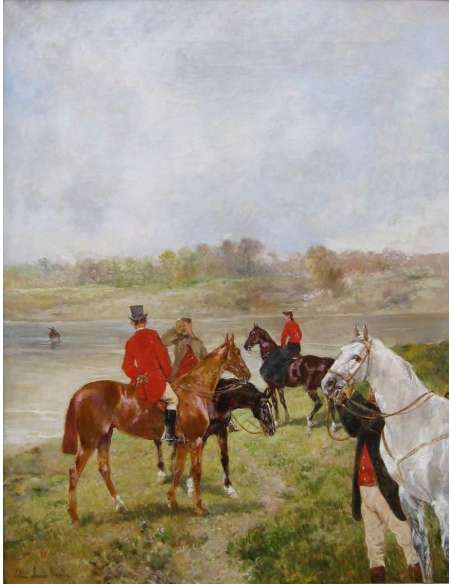"BROWN John, Lewis (Bordeaux 1829, Paris 1890)- Bat-l'eau, hunting scene to run."
Oil on canvas
Signed at the bottom left
Dimensions: 65 x 50 cm, with frame: 78 x 62 cm.
Old exhibition label on the back with the artist's name, an exhibition number 656 and titled "The edge of the pond"
John Lewis Brown was born in Bordeaux to a family of English dignitaries of the eighteenth century. Coming from Scotland, the Browns would have introduced the breed of pure English blood in France.
The present table illustrates a hunting party. The scene illustrates the bat-l'eau, the moment of the hunt when the hunted animal takes refuge in the water.
The horses and men are at a standstill, the hunters abandon the pursuit. With humor, the painter gives the man in the foreground the head of his white horse.
The painter pays all his pictorial attention to the beast, the man is no more than a colorful anecdote. The touch is free and precise, the bright colors and the reduced palette. He paints with a clear, assertive style. The artist refuses academicism as well as the romantic humanization of the beast, only he is interested in the tamed horse, which he studies in the exercise of his duties.
At the beginning of the century, the interest that is carried to Lewis Brown is more linked to his late rallying to Impressionism than to his first way. From his second pictorial impulse, he corresponds with Pissarro, Manet, Degas, Sisley, Isabey.Sa palette brightens up when he joins the Impressionists in Paris.
During his lifetime, John Lewis Brown moved away from the politics of salons and institutional events. In 1848, he started at the Salon with a Drum, and did not exhibit again until 1859. The artist only wants to know the joy of painting: he intends to be only his painter, his analyst, his psychologist, poet of his attitudes and his preferences.
His ambition is to adore horses and to paint them with près.Si the painter gives himself masters, Géricault surpasses them all. He admires him for having "enjoyed himself in the real stables, among the pride, the brutality and everything that there is more horse in the horse".
His father is the owner of a castle in Bordeaux, a wine estate still in operation today. The stud farm he owns is his son's first step towards equine painting: he tirelessly copies and draws horses. The painter is self-taught, he works for two years at the Haras des Pins and looks at the work of Bonington, distant precursor of Impressionism towards whom he shows his sympathy.
He copies Cuyp, Karel, PhilipsWouverman, goes around Italy twice. In 1852, he spent a long stay in Copenhagen to respond to a commission from the French state, copying Rembrandt's Emmaus Pilgrims. The painter meets success by exhibitions in the provinces, receives a gold medal in Limoges. His birth makes him legitimate with the aristocracy that he portrays for a time.
Bibliography: We owe most of the biographical information about the painter to his brother, Ralf Brown, inspector of Fine Arts in Paris. He talks directly with Léonce Bénédicte, curator of the Luxembourg Museum and editor of the artist's exhibition catalog.
. Léonce Bénédicte, John Lewis Brown, biographical and critical study, catalog of the engraved and lithographed work of the artist, Paris, Bookshop of Ancient and Modern Art, 1903.
Exhibition:
. cat. exp. Gilberte Martin-Méry, Jacques Chaban-Delmas, Pierre Schommer, John Lewis Brown, 1829-1890, [exhibition: Bordeaux, Gallery of Fine Arts, from Oct. 19. as of Nov. 9. 1953] Bordeaux, Delmas, 1953.
Museums: preserved at the Musée d'Orsay, Paris and at the National Gallery, London
Description
Reviews
No reviews
BROWN John , Lewis (Bordeaux 1829, Paris 1890)- Bat-l'eau, hunting scene.
Vendu
12000 €









Period:
XIX th c.
Style:
Classical Art
Material:
Oil on canvas
Signatures:
BROWN John
Origin:
French school
- Widht :
- 50 cm (19,5 In)
- Height :
- 65 cm (25,35 In)
2023-02-03
935 people viewed this item

 English
English  Français
Français








